by Venchito Tampon Jr | Last Updated on October 16, 2023
The strongest backlinks can immensely impact a site’s online rankings in Google’s SERPs.
Even if Google announces that links are no longer the top three ranking signals, we’ve seen the power of links in ranking category pages and SaaS product pages, with our link building services, from nowhere on Google’s SERPs to dominating the top spots on page 1.
Without quality content, links can only do so much. With constant updates from Google – core updates and Helpful Content updates, you can’t simply build links without the proper foundation. It has to complement the quality of content you publish on your site.
That’s why we strongly advise SEO clients to build their technical SEO and on-page SEO and consistently publish quality content that satisfies users before diving into link acquisition (this warrants another blog post).
In this guide, we dive into the best backlinks to acquire and how to get them.
What Are The Best Backlinks To Get For Your Website?
The level of potency of a backlink depends on many factors, but as general advice, you should be getting a link considering these four critical metrics.
Relevance, Trust, Authority and Branding
Relevance
Acquire links from websites that operate within the same niche or website as you own. If your brand sells coffee machines, aim to get links from coffee or food blogs.
Some niches only have limited link prospects to contact, so that’s when you consider other degrees of link relevance. This means you widen the scope of link prospecting to tap into other areas outside your niche that are still topically relevant to your site.
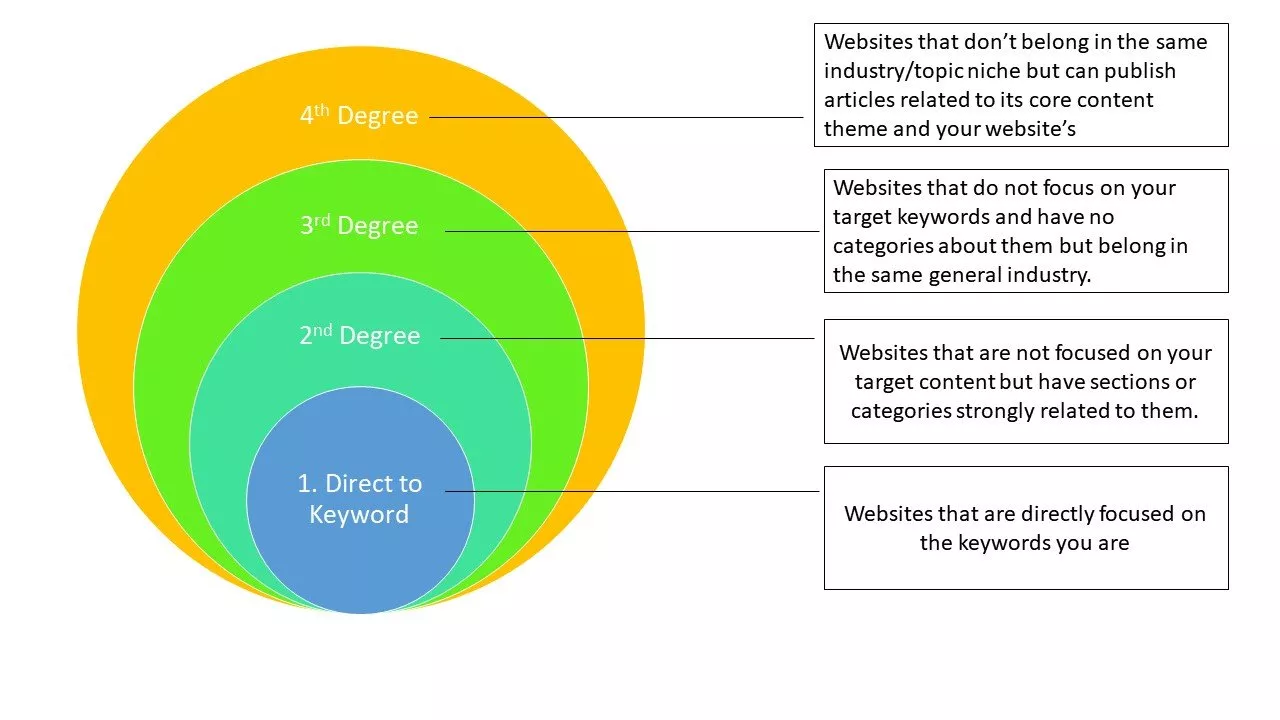 From our example, you can consider health and fitness blogs with relevant food and coffee articles (third and fourth degree of topical relevance).
From our example, you can consider health and fitness blogs with relevant food and coffee articles (third and fourth degree of topical relevance).
Trust
Majestic SEO’s Trust Flow is a good metric to use when checking how trustworthy the site is. Basically, it helps determine how closely the site is linked to seed sites manually handpicked by Majestic. These seed domains are legitimately reputable, and getting links from them are sites that are truly deserving.
Aim links from sites with a Trust Flow of 15.
Authority
Link intelligence tools like Ahrefs, Moz, and Majestic invent authority metrics. These metrics are based primarily on the quality and quantity of links pointing to its pages. And so, the more link equity a website has, the more it can pass to others via external links.
For link building strategies like guest blogging, target sites with at least an Ahrefs Domain Rating of 25 or above or Moz Domain Authority of 30 and above.
Remember, I used arbitrary numbers for this benchmark. Narrow your selection depending on the authority of your site.
As general advice, you should get links from sites with higher DR than yours to keep climbing up for bigger authority signals.
Branding
We’ll cover more on this in our section later on, getting links from entities you want your brand to associate with.
But you have to consider the type of sites you’re engaging with. Are these domains just contacts to get links from, or could they help widen your business’s reach (or be potential clients or suppliers for your store)?
How to Build The Strongest Backlinks?
1. Check Your Best Backlinks
The best place to initiate link building is to look at your site’s backlink profile. If that’s an SEO client, they may have a couple of strong domains pointing to the site that you or their team may not be aware of.
Enter the website URL on Ahrefs Site Explorer to get an overview of their backlink profile.
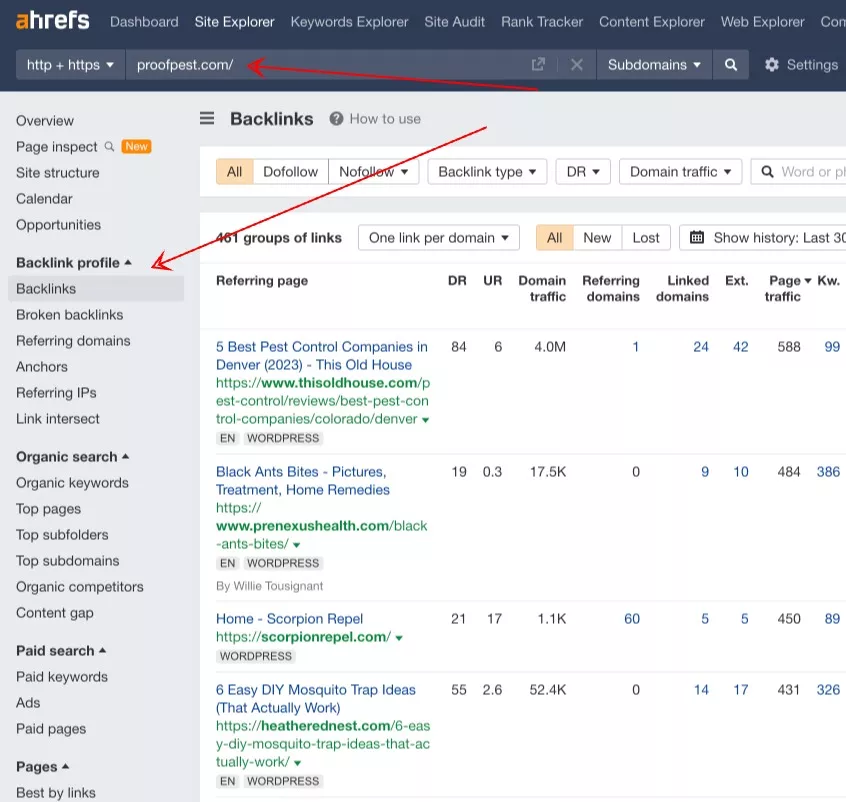
Identify Strong Referring Domains.
The best backlinks come from domains that linked to you in the past. Given either they trusted your brand, you have relationships with them, or they’ve perceived you as an authority source for content – either of these three is a good reason to get another link from their website.
Use Ahrefs filtering options to find these strong domains. Backlinks – Dofollow – DR (50+).
These strong domains may include:
- Authority publications
- Niche websites (e.g., Daily News Coffee).
- Top niche directories and citations
Getting constant editorial links from high-traffic websites drives additional referral traffic to your page.
Leverage Linkable Assets That Work.
If you’re working on a mature website, you may see existing linkable assets attracting links. These pages have targeted a linkable audience (“group of linkers”) and have a proven content type you can replicate for your next content.
To identify these linkable assets, go to the “Best by links” section in Ahrefs Site Explorer. These pages are sorted from highest to lowest number of referring domains, so you know exactly which asset has attracted the most backlinks.
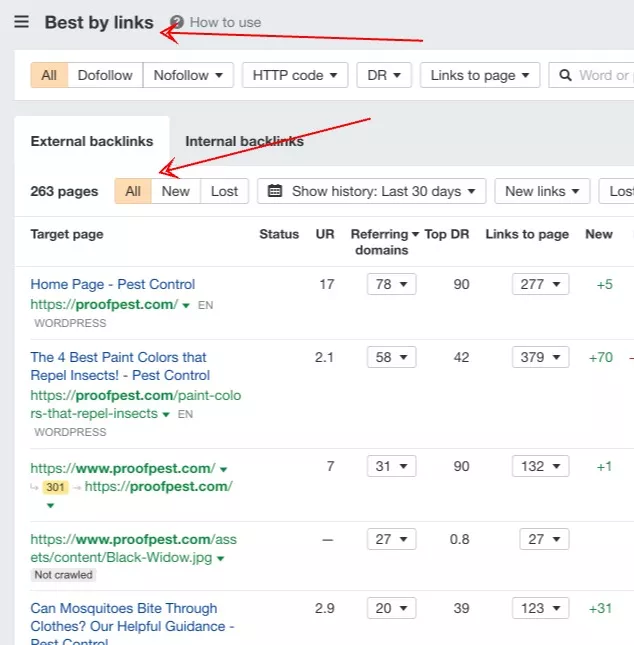
Another tip here is to look at newly published pages with fresh links. Given that they’ve recently updated the page, creators of these pages are more likely to be receptive to email outreach.
It’s also a good way to get a radar of which publications/blogs in your industry are participating in natural linking.
Determine Anchor Texts To Use.
Find keywords your site is currently ranking for. This is where you should start, as Google initially sees your site relevant to these industry terms.
Go to Organic Search – Keywords. Filter the results from position 6 to 20 and a search volume of at least 100.
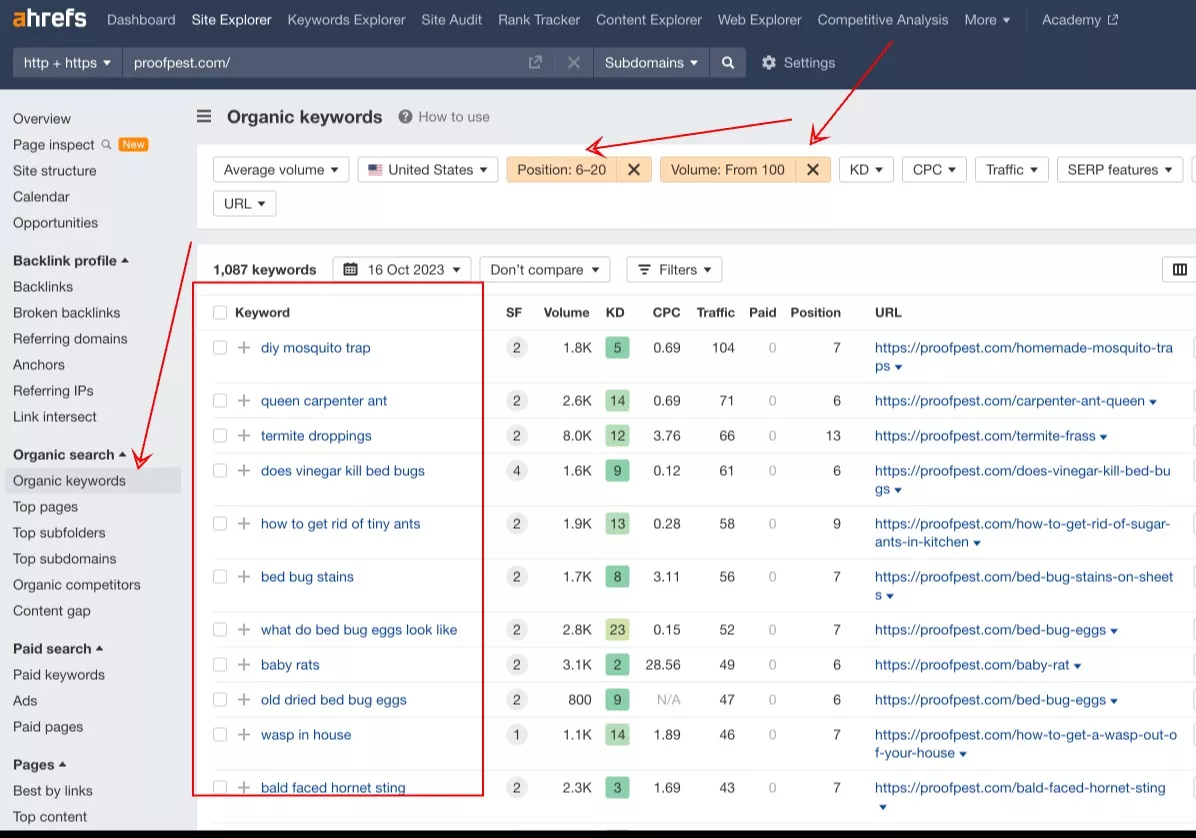
You can use these keywords as anchor texts for pages you’re trying to build up from lower page 1 to the top 3 spots of Google’s SERPs. You might only need a few more links to improve these pages’ rankings.
2. Reverse Engineer Organic Competitors
Sites currently ranking may have a proven link strategy that works for them. Reverse engineering their link profile may open new insights and link opportunities you can replicate (or take advantage of) for your site.
If you don’t know your competitors yet, enter your site’s URL on Ahrefs’ Site Explorer and choose Organic Search – Organic Competitors.
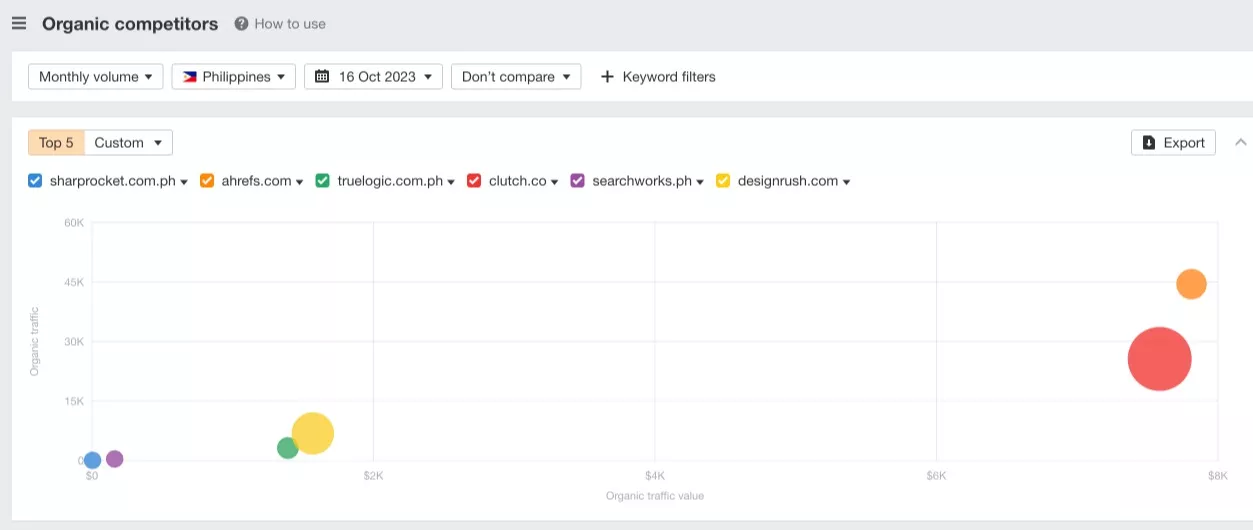
Circles indicate the number of pages your competitors have published on their site. Placements of these circles show their respective organic traffic and value. The closer they are to the right section, the bigger the traffic and value the site has.
Ahrefs is good at identifying your site’s organic search competitors. But if you want more in-depth, you can simply use Google to find top-ranking sites for your head terms.
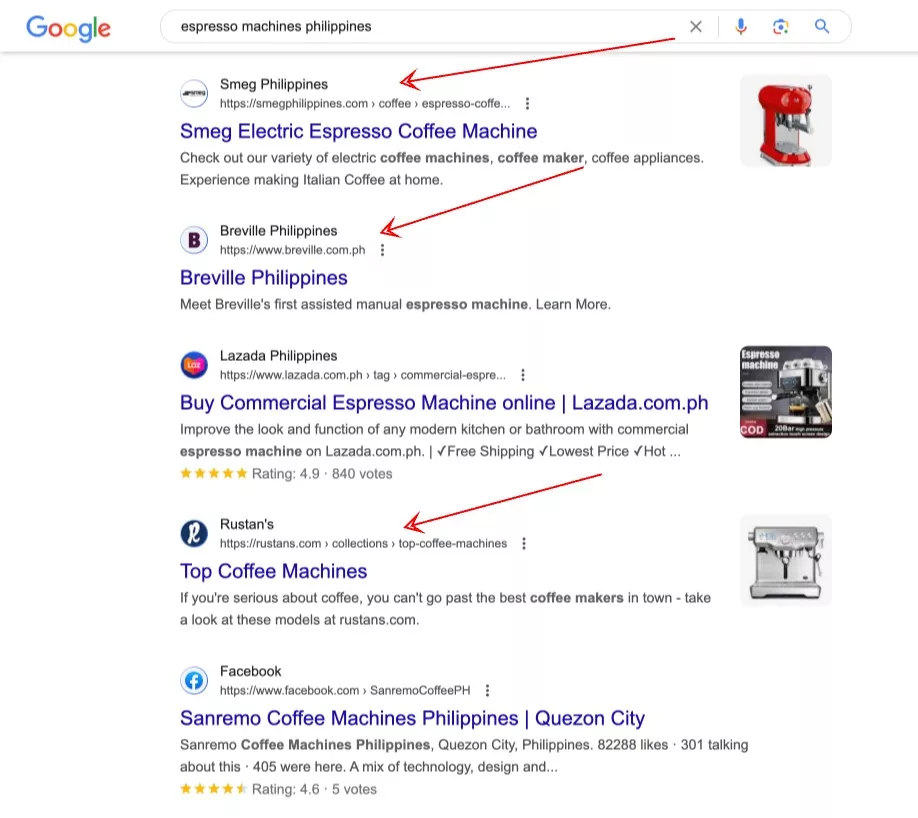
Now that you have a list of organic competitors to analyze let’s see what value you can get from them.
Get Insights For Content Types and Link Patterns
Different industries may have distinct patterns of natural linking. You’ll be more likely to observe it based on the type of blog posts or pages that are mostly linked to your site.
Enter the URL of one of your organic competitors. See “Best by links” and set “3” for “New links”.
Look at the pages receiving new links for the past days/weeks. It may indicate the freshness of content and its linkability. These pages that constantly attract new links can inspire topics for your content.
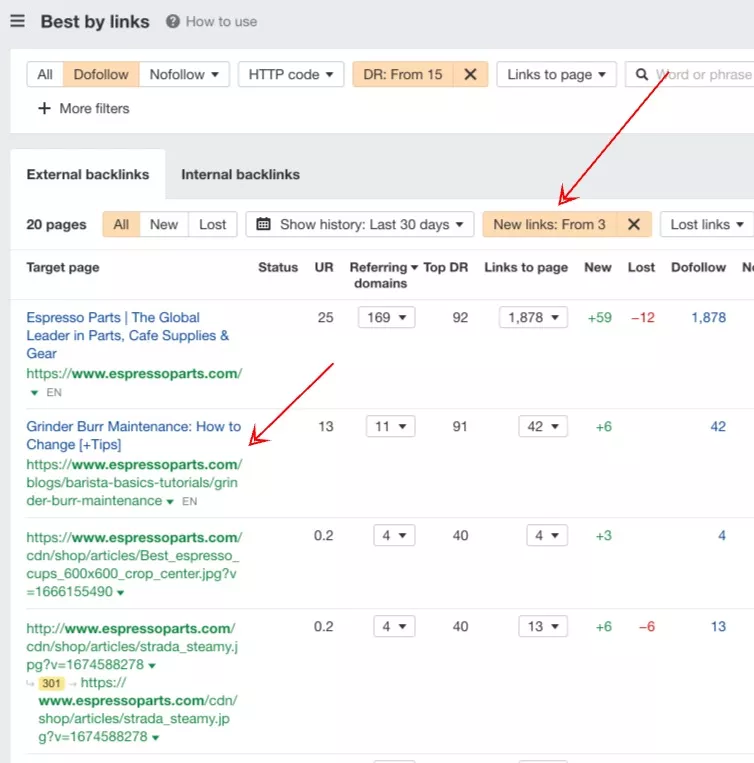
For instance, I’ve noticed this blog post from Espresso Parts that has received an additional 6 links for the past 7 days – Ahrefs’ recent indexed links (though Ahrefs may not be indexing links real-time, it’s still a good tool to monitor fresh links).
Checking the page’s organic performance indicates they’re ranking for keywords like “espresso not coming out”, or “troubleshooting espresso machine”.
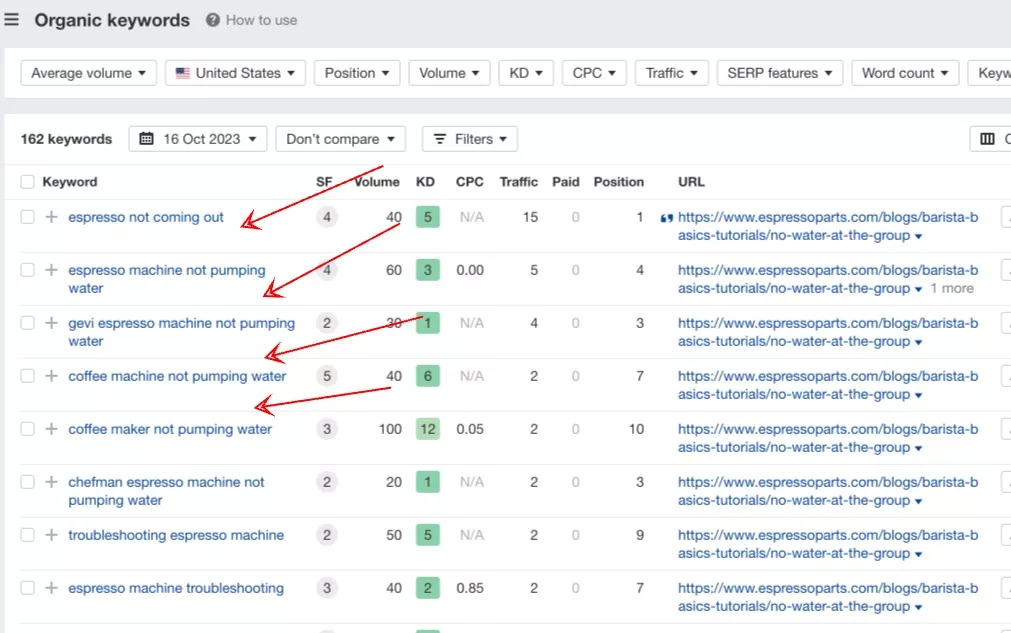
I know for a fact that most baristas and cafe owner’s greatest challenge is in the troubleshooting part of coffee brewing using espresso machines.
Now, instead of randomly picking topics, I could create a series of troubleshooting guides showcasing how baristas can fix technical issues with their espresso machines.
By checking competitors’ new linkable content, you’ll find new topics to create for your blog that are likely to attract links when they rank in Google’s SERPs.
Formulate a Link Acquisition Strategy Based On Available Link Opportunities
This is a common tactic in getting strong backlinks to your site. Checking what types of links and how they acquired them can help formulate a link strategy that best fits you.
Run your competitor’s domain using Site Explorer. Go to Backlinks – Referring Domains.
Use the numbers I mentioned earlier to assess your site’s link profile (DR60+, Dofollow, Domain Traffic 5K).
This would require a manual approach, checking each inbound link with its anchor text and destination page (what page is it linking to).
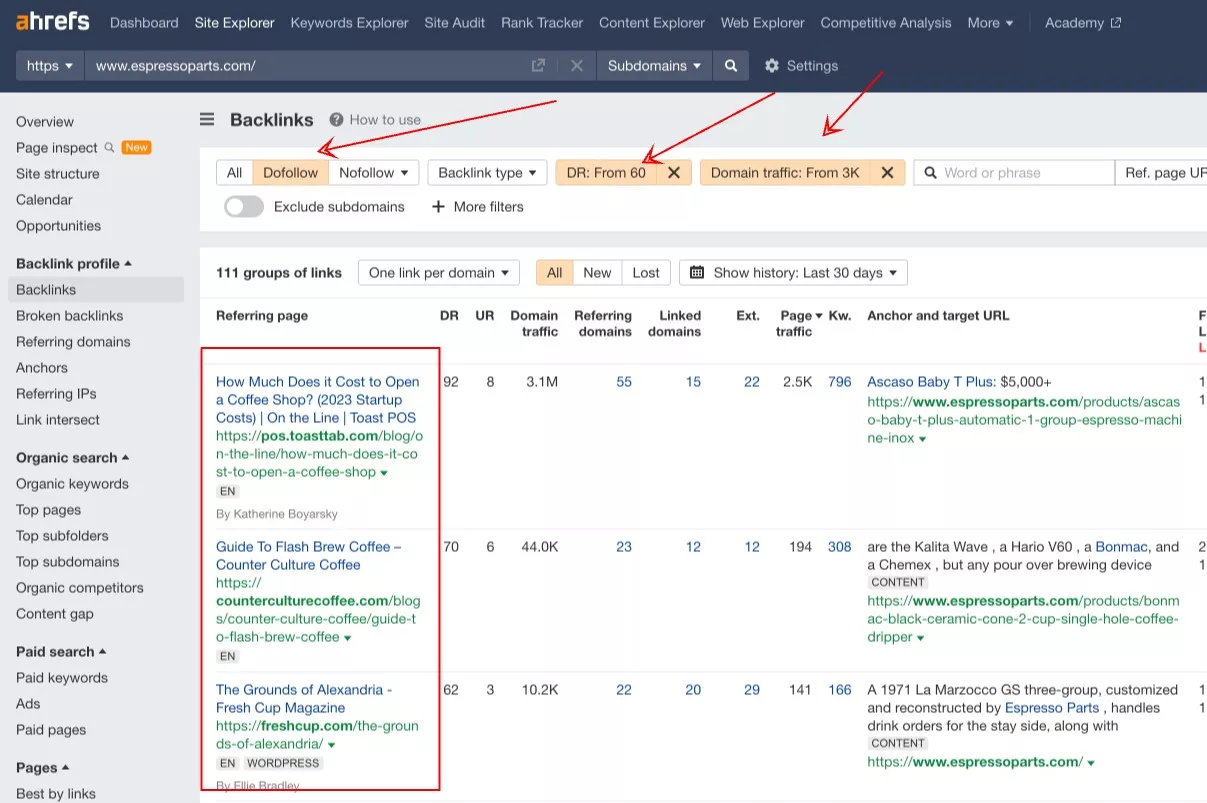
From the given example, I could create new ideas from a competitor’s strongest links:
- These product links from Toasttab, CounterCulture Coffee, and Eater result from ranking product pages and Espresso Part’s reputation in the industry. It could also be because of digital PR or the first to launch a new product that attracted buzz from niche product review writers. This sparks insights into how we can leverage new products’ to garner attention from high publications, resulting in brand/product mentions (and potentially links).
- Link on The Wicked Noodle’s National Cappucino Day – are there any celebration or seasonal days in your niche when you can develop creative digital PR campaigns?
By assessing your competitors’ exact links and link types, you can get insights into the specific link building techniques currently working in your space. You can only observe nuances in link acquisition through competitor link analysis.
Steal Best Ideas From Similar Businesses in Other Cities
If you’re doing local SEO, the best way to inspire new link building strategies is to steal from similar businesses in other cities.
Bigger cities like New York typically are competitive in search, and you’ll find that most local businesses in those highly populated cities are predominantly investing (or pretty creative) in acquiring local links for their businesses.
And by reverse engineering what they’ve done, you’ll find creative ideas you can apply to your local business.
Do a Google search for niche-related local businesses in one major city.
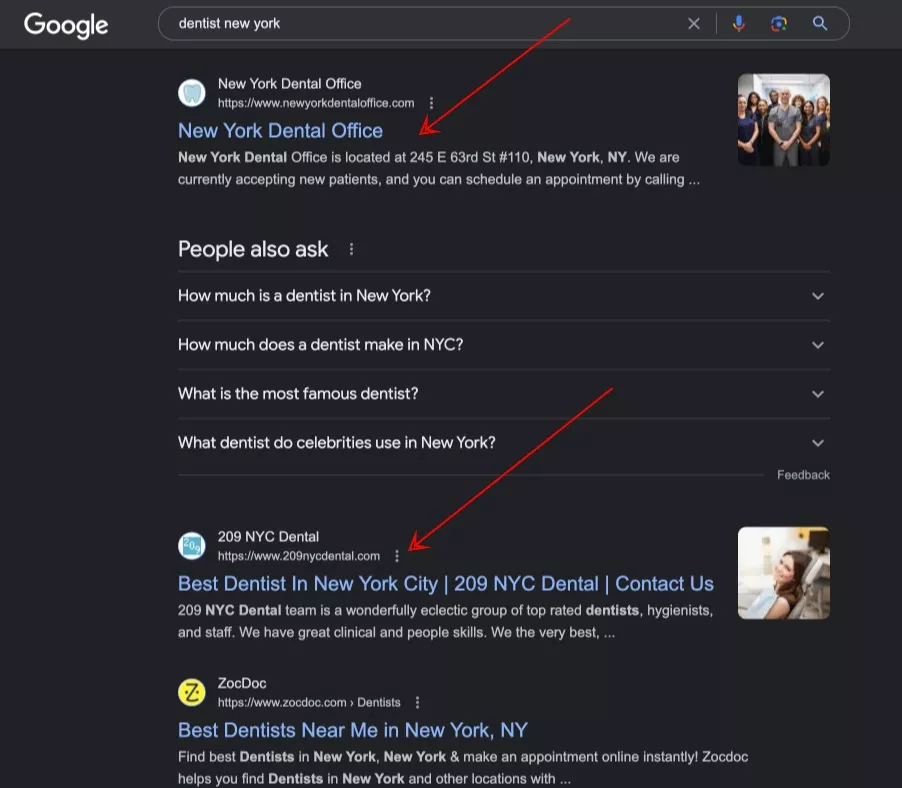
Extract their best links using Ahrefs. Repeat the same process for other ranking local businesses similar to your brand.

Then, investigate how they have gotten those links. Scan each link (or check manually) to find any page where you could find something interesting.
Here are some interesting findings from doing local competitor analysis:
- How America Started Brushing (for local dentists in NYC) – I could create historical guides for my other local businesses.
- NYMag link (for a flower shop in NYC) – do I have some brand stories I can leverage for a local digital PR campaign to get mentions/links from local newspapers?
- Our Favorite Florists and Flower Shops List (for a flower shop In NYC) – prospect for hotels that curate a list of X businesses in location?
I’m only scratching the surface, and I guess there are other link approaches you can find when you see similar businesses in major cities. Test in your local site and scale as you acquire links.
3. Automate Link Building Via Ranking For Research Queries
Manual outreach and follow-ups aren’t enough. Most SEOs doing link building outreach (even our agency) see artificial link building via outreach becoming more difficult, as most publishers now have higher expectations when they read outreach emails.
This probes for alternative ways of getting stronger backlinks to your website to automate link acquisition.
The best way to automate links is to rank for research queries or any informational keywords content creators search for when looking for additional references or citations.
During their research stage of content creation, writers seek to expound certain words or information on their page. And if they find a page covering the topic comprehensively, they’ll link to it from their own content.
Add questions that people might use when looking for sources to support their subtopics.
Place FAQs as part of subheadings and supporting details in your content instead of putting them separately at the end of the article.
I’ve noticed Google could easily understand now what your content is about based on how you properly structure your content.
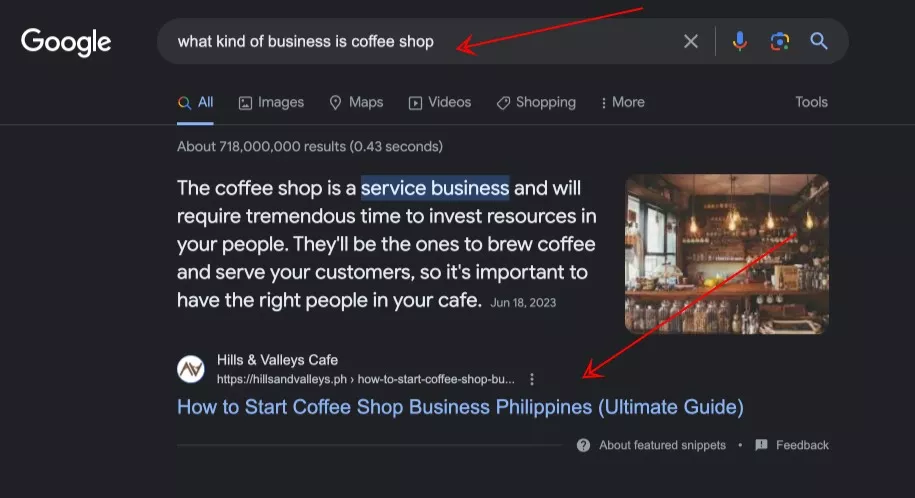
Build artificial links to push the ranking power of these pages.
If your site has a significant domain authority, it is easier for you to rank new content for research queries. For newer sites or lower authority sites, it would require manual link building to push rankings of your page.
This is when you do manual link building using guest posting, broken link building, resource page link building, and niche edits to acquire contextual links to informational content.
You can also build internal links to your linkable asset from your site’s highly linked pages (pages with the most inbound links) to pass some link equity to your info page.
After properly optimizing your content and getting some artificial links, you’ll start ranking for research queries (or their variations) and now attracting natural links from other content creators.
4. Strengthen Brand Through Entity Stacking
Some powerful backlinks can only be acquired through relationships. Your competitors can only replicate these links if they have similar connections with those giving you links.
Start building rapport with high-level entities (sites with which you want to associate your brand). This sends off-site signals to Google that your site targets a specific area of expertise (niche), which helps associate your domain with your target words and phrases.
Build social profiles, citations, and local & niche-specific directory links.
Foundational link building is when you start building links that help send relevance and trust signals to your site (off-page).
Considering sites take time before Google trusts their domains, settling the basic backlinks (but strong ones) is vital.
Foundational links include social profiles, citations, and local niche-specific directories.
Build links like what a typical business does. A legit business will create social profiles like (Facebook, Twitter, Instagram, etc..) fill out all the information on their profile, and use the platforms to promote their content/brand.

Citations are great in promoting NAP consistency, a strong local ranking factor to help your site appear on local map packs.
Develop content partnerships with non-competing blogs.
In bringing value to your email outreach campaigns, seeking mutual benefits for both parties is essential.
The last thing you want to do is pressure your link recipient to give you the link you want without the person reading the value in your email. You should always answer the question, “What’s in it for them?”.
For instance, I’ve collaborated with a coffee blogger to mutually publish content assets on both blogs (not duplicate content). We build reciprocal links, linking to their content from my statistics page and their page to ours.
An interesting angle here is that we don’t compete with each other. My coffee blog is for lead generation purposes (driving inquiries to our B2B franchise services), while his blog is focused on promoting affiliate products and programs.
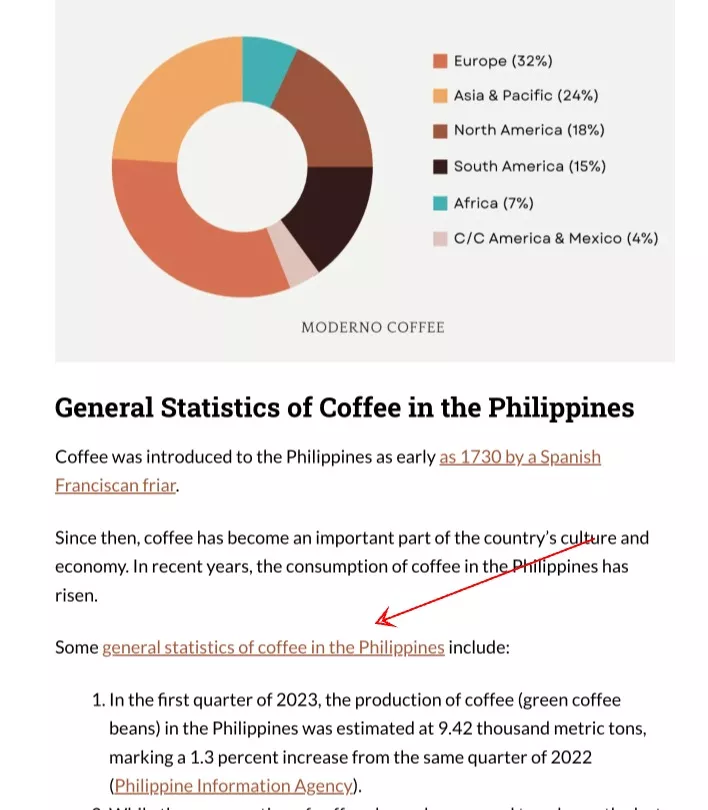
Think of the type of non-competing entities (businesses and individuals) that you’re likely to achieve mutual benefit by co-promoting each other’s content assets.
This is what regular businesses do offline, and if you can utilize the same principle online, you’re likely to succeed in getting stronger backlinks to your brand.
Target legit business sites as link prospects.
The game has changed in link building. Most niche site bloggers and content creators require initial payment in exchange for links (i.e., link buying is dominant these days).
One way to differentiate and still acquire links without incentivizing webmasters with money is to help legitimate business sites struggling to get more website traffic.
A typical business website doesn’t know much about SEO and what it can do for its site – an angle you can use in your email outreach campaign.
Instead of merely offering short-term incentives (i.e., money), you provide to do the work for them.
One way is to send quick reports of industry keywords (or one topic cluster of keywords) they can target for their blog content. Add some suggestions for basic on-page optimization they may have missed doing on their site’s key landing pages.
All these may take 10 to 30 minutes of work but could result in a contextual link to your site.
By providing so much value to business site owners (some of whom don’t have their SEO specialists working in-house), you can request a specific anchor text and link placement that could enhance the value of links you’ll get from the site.
That’s it.
If you have questions, follow me on Twitter @venchito14 and Linkedin.
The Author
Venchito Tampon Jr
Venchito Tampon is a Filipino Motivational Speaker, Corporate Trainer, and a Leadership Speaker in the Philippines. He is the CEO and Co-Founder of SharpRocket, a link building agency. With a decade of experience, Venchito has a proven track record of leading hundreds of successful SEO (link builidng) campaigns across competitive industries like finance, B2B, legal, and SaaS. His expert advice as a link building expert has been featured in renowned publications such as Semrush, Ahrefs, Huffington Post and Forbes. He is also an international SEO spoken and has delivered talks in SEO Zraz, Asia Pacific Affiliate Summit in Singapore, and Search Marketing Summit in Sydney, Australia. Check out his other businesses, Hills & Valleys Cafe, Blend N Sips and Saas Pursuit.
How our LINK BUILDING AGENCY builds 250 links/mo consistently using Predictable Link Building Methodology™…
- Using a SIMPLE and PROVEN system
- Using a SCALABLE strategy
- No private blog networks
- No creepy outreach emails
